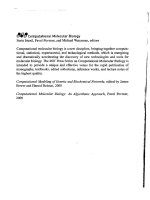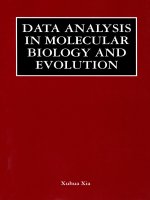current topics in computational molecular biology - tao jiang , ying xu , michael q. zhang
Bạn đang xem bản rút gọn của tài liệu. Xem và tải ngay bản đầy đủ của tài liệu tại đây (11.08 MB, 556 trang )
Current Topics in Computational Molecular Biology
Computational Molecular Biology
Sorin Istrail, Pavel Pevzner, and Michael Waterman, editors
Computational Methods for Modeling Biochemical Networks
James M. Bower and Hamid Bolouri, editors, 2000
Computational Molecular Biology: An Algorithmic Approach
Pavel A. Pevzner, 2000
Current Topics in Computational Molecular Biology
Tao Jiang, Ying Xu, and Michael Q. Zhang, editors, 2002
Current Topics in Computational Molecular Biology
edited by
Tao Jiang
Ying Xu
Michael Q. Zhang
A Bradford Book
The MIT Press
Cambridge, Massachusetts
London, England
( 2002 Massachusetts Institute of Technology
All rights reserved. No part of this book may be reproduced in any form by any electronic or mechanical
means (including photocopying, recording, or information storage and retrieval) without permission in
writing from the publisher.
Published in association with Tsinghua University Press, Beijing, China, as part of TUP’s Frontiers of
Science and Technology for the 21st Century Series.
This book was set in Times New Roman on 3B2 by Asco Typesetters, Hong Kong and was printed and
bound in the United States of America.
Library of Congress Cataloging-in-Publication Data
Current topics in computational molecular biology / edited by Tao Jiang, Ying Xu, Michael Zhang.
p. cm. — (Computer molecular biology)
Includes bibliographical references.
ISBN 0-262-10092-4 (hc. : alk. paper)
1. Molecular biology—Mathematics. 2. Molecular biology—Data processing. I. Jiang, Tao, 1963–
II. Xu, Ying. III. Zhang, Michael. IV. Series.
QH506 .C88 2002
572.80 010 51—dc21
2001044430
Contents
Preface
vii
I
INTRODUCTION
1
1
The Challenges Facing Genomic Informatics
Temple F. Smith
3
II
COMPARATIVE SEQUENCE AND GENOME ANALYSIS
9
2
Bayesian Modeling and Computation in Bioinformatics Research
Jun S. Liu
11
3
Bio-Sequence Comparison and Applications
Xiaoqiu Huang
45
4
Algorithmic Methods for Multiple Sequence Alignment
Tao Jiang and Lusheng Wang
71
5
Phylogenetics and the Quartet Method
Paul Kearney
111
6
Genome Rearrangement
David SankoÔ and Nadia El-Mabrouk
135
7
Compressing DNA Sequences
Ming Li
157
III
DATA MINING AND PATTERN DISCOVERY
173
8
Linkage Analysis of Quantitative Traits
Shizhong Xu
175
9
Finding Genes by Computer: Probabilistic and Discriminative
Approaches
Victor V. Solovyev
201
10
Computational Methods for Promoter Recognition
Michael Q. Zhang
249
11
Algorithmic Approaches to Clustering Gene Expression Data
Ron Shamir and Roded Sharan
269
12
KEGG for Computational Genomics
Minoru Kanehisa and Susumu Goto
301
vi
Contents
13
Datamining: Discovering Information from Bio-Data
Limsoon Wong
317
IV
COMPUTATIONAL STRUCTURAL BIOLOGY
343
14
RNA Secondary Structure Prediction
Zhuozhi Wang and Kaizhong Zhang
345
15
Properties and Prediction of Protein Secondary Structure
Victor V. Solovyev and Ilya N. Shindyalov
365
16
Computational Methods for Protein Folding: Scaling a Hierarchy of
Complexities
Hue Sun Chan, Huseyin Kaya, and Seishi Shimizu
ă
17
18
19
Protein Structure Prediction by Comparison: Homology-Based
Modeling
Manuel C. Peitsch, Torsten Schwede, Alexander Diemand, and
Nicolas Guex
403
449
Protein Structure Prediction by Protein Threading and Partial
Experimental Data
Ying Xu and Dong Xu
467
Computational Methods for Docking and Applications to Drug Design:
Functional Epitopes and Combinatorial Libraries
Ruth Nussinov, Buyong Ma, and Haim J. Wolfson
503
Contributors
Index
525
527
Preface
Science is advanced by new observations and technologies. The Human Genome
Project has led to a massive outpouring of genomic data, which has in turn fueled
the rapid developments of high-throughput biotechnologies. We are witnessing a
revolution driven by the high-throughput biotechnologies and data, a revolution that is
transforming the entire biomedical research field into a new systems level of genomics,
transcriptomics, and proteomics, fundamentally changing how biological science and
medical research are done. This revolution would not have been possible if there had
not been a parallel emergence of the new field of computational molecular biology,
or bioinformatics, as many people would call it. Computational molecular biology/
bioinformatics is interdisciplinary by nature and calls upon expertise in many diÔerent
disciplinesbiology, mathematics, statistics, physics, chemistry, computer science,
and engineering; and is ubiquitous at the heart of all large-scale and high-throughput
biotechnologies. Though, like many emerging interdisciplinary fields, it has not yet
found its own natural home department within traditional university settings, it has
been identified as one of the top strategic growing areas throughout academic as well
as industrial institutions because of its vital role in genomics and proteomics, and its
profound impact on health and medicine.
At the eve of the completion of the human genome sequencing and annotation, we
believe it would be very useful and timely to bring out this up-to-date survey of current topics in computational molecular biology. Because this is a rapidly developing
field and covers a very wide range of topics, it is extremely di‰cult for any individual
to write a comprehensive book. We are fortunate to be able to pull together a team of
renowned experts who have been actively working at the forefront of each major area
of the field. This book covers most of the important topics in computational molecular biology, ranging from traditional ones such as protein structure modeling and
sequence alignment, to the recently emerged ones such as expression data analysis
and comparative genomics. It also contains a general introduction to the field, as well
as a chapter on general statistical modeling and computational techniques in molecular biology. Although there are already several books on computational molecular
biology/bioinformatics, we believe that this book is unique as it covers a wide spectrum of topics (including a number of new ones not covered in existing books, such
as gene expression analysis and pathway databases) and it combines algorithmic,
statistical, database, and AI-based methods for biological problems.
Although we have tried to organize the chapters in a logical order, each chapter is
a self-contained review of a specific subject. It typically starts with a brief overview of
a particular subject, then describes in detail the computational techniques used and
the computational results generated, and ends with open challenges. Hence the reader
need not read the chapters sequentially. We have selected the topics carefully so that
viii
Preface
the book would be useful to a broad readership, including students, nonprofessionals,
and bioinformatic experts who want to brush up topics related to their own research
areas.
The 19 chapters are grouped into four sections. The introductory section is a chapter
by Temple Smith, who attempts to set bioinformatics into a useful historical context.
For over half a century, mathematics and even computer-based analyses have played
a fundamental role in bringing our biological understanding to its current level. To a
very large extent, what is new is the type and sheer volume of new data. The birth of
bioinformatics was a direct result of this new data explosion. As this interdisciplinary
area matures, it is providing the data and computational support for functional
genomics, which is defined as the research domain focused on linking the behavior of
cells, organisms, and populations to the information encoded in the genomes.
The second of the four sections consists of six chapters on computational methods
for comparative sequence and genome analyses.
Liu’s chapter presents a systematic development of the basic Bayesian methods
alongside contrasting classical statistics procedures, emphasizing the conceptual importance of statistical modeling and the coherent nature of the Bayesian methodology.
The missing data formulation is singled out as a constructive framework to help one
build comprehensive Bayesian models and design e‰cient computational strategies.
Liu describes the powerful computational techniques needed in Bayesian analysis,
including the expectation-maximization algorithm for finding the marginal mode,
Markov chain Monte Carlo algorithms for simulating from complex posterior distributions, and dynamic programming-like recursive procedures for marginalizing out
uninteresting parameters or missing data. Liu shows that the popular motif sampler
used for finding gene regulatory binding motifs and for aligning subtle protein motifs
can be derived easily from a Bayesian missing data formulation.
Huang’s chapter focuses on methods for comparing two sequences and their
applications in the analysis of DNA and protein sequences. He presents a global
alignment algorithm for comparing two sequences that are entirely similar. He also
describes a local alignment algorithm for comparing sequences that contain locally
similar regions. The chapter gives e‰cient computational techniques for comparing
two long sequences and comparing two sets of sequences, and it provides real applications to illustrate the usefulness of sequence alignment programs in the analysis of
DNA and protein sequences.
The chapter by Jiang and Wang provides a survey on computational methods
for multiple sequence alignment, which is a fundamental and challenging problem
in computational molecular biology. Algorithms for multiple sequence alignment
are routinely used to find conserved regions in biomolecular sequences, to construct
Preface
ix
family and superfamily representations of sequences, and to reveal evolutionary
histories of species (or genes). The authors discuss some of the most popular
mathematical models for multiple sequence alignment and e‰cient approximation
algorithms for computing optimal multiple alignment under these models. The main
focus of the chapter is on recent advances in combinatorial (as opposed to stochastic)
algorithms.
Kearney’s chapter illustrates the basic concepts in phylogenetics, the design and
development of computational tools for evolutionary analyses, using the quartet
method as an example. Quartet methods have recently received much attention in the
research community. This chapter begins by examining the mathematical, computational, and biological foundations of the quartet method. A survey of the major
contributions to the method reveals an excess of diverse and interesting concepts indicative of a ripening research topic. These contributions are examined critically with
strengths, weakness, and open problems.
SankoÔ and El-Mabrouks chapter describes the basic concepts of genome rearrangement and applications. Genome structure evolves through a number of nonlocal rearrangement processes that may involve an arbitrarily large proportion of a
chromosome. The formal analysis of rearrangements diÔers greatly from DNA and
protein comparison algorithms. In this chapter, the authors formalize the notion of a
genome in terms of a set of chromosomes, each consisting of an ordered set of genes.
The chapter surveys genomic distance problems, including the Hannenhalli-Pevzner
theory for reversals and translocations, and covers the progress to date on phylogenetic extensions of rearrangement analysis. Recent work focuses on problems of gene
and genome duplication and their implications for genomic distance and genomebased phylogeny.
The chapter by Li describes the author’s work on compressing DNA sequences
and applications. The chapter concentrates on two programs the author has developed: a lossless compression algorithm, GenCompress, which achieves the best compression ratios for benchmark sequences; and an entropy estimation program, GTAC,
which achieves the lowest entropy estimation for benchmark DNA sequences. The
author then discusses a new information-based distance measure between two sequences and shows how to use the compression programs as heuristics to realize such
distance measures. Some experiments are described to demonstrate how such a theory
can be used to compare genomes.
The third section covers computational methods for mining biological data and
discovering patterns hidden in the data.
The chapter by Xu presents an overview of the major statistical techniques for
quantitative trait analysis. Quantitative traits are defined as traits that have a con-
x
Preface
tinuous phenotypic distribution. Variances of these traits are often controlled by the
segregation of multiple loci plus an environmental variance. Localization of these
quantitative trait loci (QTL) on the chromosomes and estimation of their eÔects
using molecular markers are called QTL linkage analysis or QTL mapping. Results
of QTL mapping can help molecular biologists target particular chromosomal regions and eventually clone genes of functional importance.
The chapter by Solovyev describes statistically based methods for the recognition
of eukaryotic genes. Computational gene identification is an issue of vital importance
as a tool of identifying biologically relevant features (protein coding sequences), which
often cannot be found by the traditional sequence database searching technique.
Solovyev reviews the structure and significant characteristics of gene components,
and discusses recent advances and open problems in gene-finding methodology and
its application to sequence annotation of long genomic sequences.
Zhang’s chapter gives an overview of computational methods currently used for
identifying eukaryotic PolII promoter elements and the transcriptional start sites.
Promoters are very important genetic elements. A PolII promoter generally resides in
the upstream region of each gene; it controls and regulates the transcription of the
downstream gene.
In their chapter, Shamir and Sharan describe some of the main algorithmic approaches to clustering gene expression data, and briefly discuss some of their properties. DNA chip technologies allow for the first time a global, simultaneous view of
the transcription levels of many thousands of genes, under various cellular conditions.
This opens great opportunities in medical, agricultural, and basic scientific research. A
key step in the analysis of gene expression data is the identification of groups of genes
that manifest similar expression patterns. This translates to the algorithmic problem of
clustering gene expression data. The authors also discuss methods for evaluating the
quality of clustering solutions in various situations, and demonstrate the performance
of the algorithms on yeast cell cycle data.
The chapter by Kanehisa and Goto dsecribes the latest developments of the
KEGG database. A key objective of the KEGG project is to computerize data and
knowledge on molecular pathways and complexes that are involved in various cellular processes. Currently KEGG consists of (1) a pathway database, (2) a genes database, (3) a genome database, (4) a gene expression database, (5) a database of binary
relations between proteins and other biological molecules, and (6) a ligand database,
plus various classification information. It is well known that the analysis of individual
molecules would not be su‰cient for understanding higher order functions of cells
and organisms. KEGG provides a computational resource for analyzing biological
networks.
Preface
xi
The chapter by Wong presents an introduction to what has come to be known as
datamining and knowledge discovery in the biomedical context. The major reason
that datamining has attracted increasing attention in the biomedical industry in recent
years is due to the increased availability of huge amount of biomedical data and the
imminent need to turn such data into useful information and knowledge. The knowledge gained can lead to improved drug targets, improved diagnostics, and improved
treatment plans.
The last section of the book, which consists of six chapters, covers computational
approaches for structure prediction and modeling of macromolecules.
Wang and Zhang’s chapter presents an overview of predictions of RNA secondary
structures. The secondary structure of an RNA is a set of base-pairs (nucleotide
pairs) that form bonds between A-U and C-G. These bonds have been traditionally
assumed to be noncrossing in a secondary structure. Two major prediction approaches
considered are thermodynamic energy minimization methods and phylogenetic comparative methods. Thermodynamic energy minimization methods have been used to
predict secondary structures from a single RNA sequence. Phylogenetic comparative
methods have been used to determine secondary structures from a set of homologous
RNAs whose sequences can be reliably aligned.
The chapter by Solovyev and Shindyalov provides a survey of computational
methods for protein secondary structure predictions. Secondary structures describe
regular features of the main chain of a protein molecule. Experimental investigation
of polypeptides and small proteins suggest that a secondary structure can form
in isolation, implying the possibility of identifying rules for its computational prediction. Predicting the secondary structure from an amino acid sequence alone is an
important step toward our understanding of protein structures and functions. It may
provide a starting point for tertiary structure modeling, especially in the absence of a
suitable homologous template structure, reducing the search space in the simulation
of protein folding.
The chapter by Chan et al. surveys currently available physics-based computational approaches to protein folding. A spectrum of methods—ranging from all-atom
molecular dynamics to highly coarse-grained lattice modeling—have been employed
to address physicochemical aspects of protein folding at various levels of structural
and energetic resolution. The chapter discusses the strengths and limitations of some
of these methods. In particular, the authors emphasize the primacy of self-contained
chain models and how they diÔer logically from non-self-contained constructs with
ad hoc conformational distributions. The important role of a protein’s aqueous environment and the general non-additivity of solvent-mediated protein interactions are
illustrated by examples in continuum electrostatics and atomic treatments of hydro-
xii
Preface
phobic interactions. Several recent applications of simple lattice protein models are
discussed in some detail.
In their chapter, Peitsch et al. discuss how protein models can be applied to
functional analysis, as well as some of the current issues and limitations inherent
to these methods. Functional analysis of the proteins discovered in fully sequenced
genomes represents the next major challenge of life science research, and computational methods play an increasingly important part. Among them, comparative
protein modeling will play a major role in this challenge, especially in light of the
Structural Genomics programs about to be started around the world.
Xu and Xu’s chapter presents a survey on protein threading as a computational
technique for protein structure calculation. The fundamental reason for protein
threading to be generally applicable is that the number of unique folds in nature is
quite small, compared to the number of protein sequences, and a significant portion
of these unique folds are already solved. A new trend in the development of computational modeling methods for protein structures, particularly in threading, is to
incorporate partial structural information into the modeling process as constraints.
This trend will become more clear as a great amount of structural data will be generated by the high-throughput structural genomics centers funded by the NIH Structural Genonics Initiative. The authors outline their recent work along this direction.
The chapter by Nussinov, Ma, and Wolson describes highly e‰cient, computervision and robotics based algorithms for docking and for the generation and matching of epitopes on molecular surfaces. The goal of frequently used approaches, both in
searches for molecular similarity and for docking, that is, molecular complementarity,
is to obtain highly accurate matching of respective molecular surfaces. Yet, owing to
the variability of molecular surfaces in solution, to flexibility, to mutational events,
and to the need to use modeled structures in addition to high resolution ones, utilization of epitopes may ultimately prove a more judicious approach to follow.
This book would not have been possible without the timely cooperation from all
the authors and the patience of the publisher. Many friends and colleagues who have
served as chapter reviewers have contributed tremendously to the quality and readability of the book. We would like to take this opportunity to thank them individually. They are: Nick Alexandrov, Vincent Berry, Mathieu Blanchette, David Bryant,
Alberto Caprara, Kun-Mao Chao, Jean-Michel Claverie, Hui-Hsien Chou, Bhaskar
DasGupta, Ramana Davuluri, Jim Fickett, Damian Gessler, Dan Gusfield, Loren
Hauser, Xiaoqiu Huang, Larry Hunter, Shuyun Le, Sonia Leach, Hong Liu, Satoru
Miyano, Ruth Nussinov, Victor Olman, Jose N. Onuchic, Larry Ruzzo, Gavin Sherlock, Jay Snoddy, Chao Tang, Ronald Taylor, John Tromp, Ilya A. Vakser, Martin
Vingron, Natascha Vukasinovic, Mike Waterman, Liping Wei, Dong Xu, Zhenyu
Preface
xiii
Xuan, Lisa Yan, Louxin Zhang, and Zheng Zhang. We would also like to thank Ray
Zhang for the artistic design of the cover page. Finally, we would like to thank
Katherine Almeida, Katherine Innis, Ann Rae Jonas, Robert V. Prior, and Michael
P. Rutter from The MIT Press for their great support and assistance throughout the
process, and Dr. Guokui Liu for connecting us with the Tsinghua University Press
(TUP) of China and facilitating copublication of this book by TUP in China.
I
INTRODUCTION
This page intentionally left blank
1
The Challenges Facing Genomic Informatics
Temple F. Smith
What are these areas of intense research labeled bioinformatics and functional
genomics? If we take literally much of the recently published ‘‘news and views,’’ it
seems that the often stated claim that the last century was the century of physics,
whereas the twenty-first will be the century of biology, rests significantly on these new
research areas. We might therefore ask: What is new about them? After all, computational or mathematical biology has been around for a long time. Surely much of
bioinformatics, particularly that associated with evolution and genetic analyses, does
not appear very new. In fact, the related work of researchers like R. A. Fisher, J. B.
S. Haldane, and Sewell Wright dates nearly to the beginning of the 1900s. The modern
analytical approaches to genetics, evolution, and ecology rest directly on their and
similar work. Even genetic mapping easily dates to the 1930s, with the work of T. S.
Painter and his students of Drosophila (still earlier if you include T. H. Morgan’s
work on X-linked markers in the fly). Thus a short historical review might provide
a useful perspective on this anticipated century of biology and allow us to view the
future from a firmer foundation.
First of all, it should be helpful to recognize that it was very early in the so-called
century of physics that modern biology began, with a paper read by Hermann Muller
ă
at a 1921 meeting in Toronto. Muller, a student of Morgans, stated that although of
ă
submicroscopic size, the gene was clearly a physical particle of complex structure, not
just a working construct! Muller noted that the gene is unique from its product, and
ă
that it is normally duplicated unchanged, but once mutated, the new form is in turn
duplicated faithfully.
The next 30 years, from the early 1920s to the early 1950s, were some of the most
revolutionary in the science of biology. In my original field of physics, the great
insights of relativity and quantum mechanics were already being taught to undergraduates; in biology, the new one-gene-one-enzyme concept was leading researchers
to new understandings in biochemistry, genetics, and evolution. The detailed physical
nature of the gene and its product were soon obtained. By midcentury, the unique
linear nature of the protein and the gene were essentially known from the work of
Frederick Sanger (Sanger 1949) and Erwin ChargraÔ (ChargraÔ 1950). All that
remained was John Kendrew’s structural analysis of sperm whale myoglobin (Kendrew 1958) and James Watson and Francis Crick’s double helical model for DNA
(Watson and Crick 1953). Thus by the mid-1950s, we had seen the physical gene and
one of its products, and the motivation was in place to find them all. Of course, the
genetic code needed to be determined and restriction enzymes discovered, but the
beginning of modern molecular biology was on its way.
4
Temple F. Smith
We might say that much of the last century was the century of applied physics, and
the last half of the century was applied molecular biochemistry, generally called molecular biology! So what happened to create bioinformatics and functional genomics?
It was, of course, the wealth of sequence data, first protein and then genomic. Both
are based on some very clever chemistry and the late 1940s molecular sizing by
chromatography. Frederick Sanger’s sequencing of insulin (Sanger 1956) and Wally
Gilbert and Allan Maxam’s sequence of the Lactose operator from E. coli (Maxam
and Gilbert 1977) showed that it could be done. Thus, in principle, all genetic sequences, including the human genome, were determinable; and, if determinable, they
were surely able to be engineered, suggesting that the economics and even the ethics
of biological research was about to change. The revolution was already visible to
some by the 1970s.
The science or discipline of analyzing and organizing sequence data defines for
many the bioinformatics realm. It had two somewhat independent beginnings. The
older was the attempt to related amino acid sequences to the three-dimensional
structure and function of proteins. The primary focus was the understanding of the
sequence’s encoding of structure and, in turn, the structure’s encoding of biochemical
function. Beginning with the early work of Sanger and Kendrew, progress continued
such that, by the mid-1960s, Margaret DayhoÔ (DayhoÔ and Eck 1966) had formally created the first major database of protein sequences. By 1973, we had the start
of the database of X-ray crystallographic determined protein atomic coordinates
under Tom Koetzle at the Brookhaven National Laboratory.
From early on, DayhoÔ seemed to understand that there was other very fundamental information available in sequence data, as shown in her many phylogenetic
trees. This was articulated most clearly by Emile Zuckerkandl and Linus Pauling as
early as 1965 (Zuckerkandl and Pauling 1965), that within the sequences lay their
evolutionary history. There was a second fossil record to be deciphered.
It was that recognition that forms the true second beginning of what is so often
thought of as the heart of bioinformatics, comparative sequence analyses. The seminal paper was by Walter Fitch and Emanuel Margoliash, in which they constructed a
phylogenetic tree from a set of cytochrome sequences (Fitch and Margoliash 1967).
With the advent of more formal analysis methods (Needleman and Wunsch 1970;
Smith and Waterman 1981; Wilbur and Lipman 1983) and larger datasets (GenBank
was started at Los Alamos in 1982), the marriage between sequence analysis and
computer science emerged as naturally as it had with the analysis of tens of thousands
of diÔraction spots in protein structure determination a decade before. As if proof
was needed that comparative sequence analysis was of more than academic interest,
Russell Doolittle (Doolittle et al. 1983) demonstrated that we could explain the onc
The Challenges Facing Genomic Informatics
5
gene v-sis’s properties as an aberrant growth factor by assuming that related functions are carried out by sequence similar proteins.
By 1990, nearly all of the comparative sequence analysis methods had been refined
and applied many times. The result was a wealth of new functional and evolutionary
hypotheses. Many of these led directly to new insights and experimental validation.
This in turn made the 40 years between 1950 and 1990 the years that brought reality
to the dreams seeded in those wondrous previous 40 years of genetics and biochemistry. It is interesting to note that during this same 40 years, computers developed
from the wartime monsters through the university mainframes and the lab bench
workstation to the powerful personal computer. In fact, Doolittle’s early successful
comparative analysis was done on one of the first personal computers, an Apple II.
The link between computers and molecular biology is further seen in the justification
of initially placing GenBank at the Los Alamos National Laboratory rather than at
an academic institution. This was due in large part to the laboratory’s then immense
computer resources, which in the year 2000 can be found in a top-of-the-line laptop!
What was new to computational biology was the data and the anticipated
amount of it. Note that the human genome project was being formally initiated by
1990. Within the century’s final decade, the genomes of more than two dozen microorganisms, along with yeast and C. elegans, the worm, would be completely sequenced. By the summer of the new century’s very first year, the fruit fly genome
would be sequenced, as well as 85 percent of the entire human genome. Although
envisioned as possible by the late 1970s, no one foresaw the wealth of full genomic
sequences that would be available at the start of the new millennium.
What challenges remained at the informatics level? Major database problems and
some additional algorithm development will still surely come about. And, even though
we still cannot predict a protein’s structure or function directly from its sequence, de
novo, straightforward sequence comparisons with such a wealth of data can generally
infer both function and structure from the identification of close homologues previously analyzed. Yet it has slowly become obvious that there are at least four major
problems here: first, most ‘‘previously analyzed’’ sequences obtained their annotation
via sequence comparative inheritance, and not by any direct experimentation; second, many proteins carry out very diÔerent cellular roles even when their biochemical
functions are similar; third, there are even proteins that have evolved to carry out
functions distinct from those carried out by their close homologues (JeÔery 1999);
and, finally, many proteins are multidomained and thus multifunctional, but identified
by only one function. When we compound these facts with the lack of any universal
vocabulary throughout much of molecular biology, there is great confusion, even
with interpreting standard sequence similarity analysis. Even more to the point of the
6
Temple F. Smith
future of bioinformatics is knowing that the function of a protein or even the role in
the cell played by that function is only the starting point for asking real biological
questions.
Asking questions beyond what biochemistry is encoded in a single protein or protein domain is still challenging. However, asking what role biochemistry plays in the
life of the cell, which many refer to as functional genomics, is clearly even more challenging from the computational side. The analysis of genes and gene networks and
their regulation may be even more complicated. Here we have to deal with alternate
spliced gene products with potentially distinct functions and highly degenerate short
DNA regulatory words. So far, sequence comparative methods have had limited
success in these cases.
What will be the future role of computation in biology in the first few decades of
this century? Surely many of the traditional comparative sequence analyses, including
homologous extension protein structure modeling and DNA signal recognition, will
continue to play major roles. As already demonstrated, standard statistical and clustering methods will be used on gene expression data. It is obvious, however, that the
challenge for the biological sciences is to begin to understand how the genome parts
list encodes cellular function—not the function of the individual parts, but that of the
whole cell and organism. This, of course, has been the motivation underlying most of
molecular biology over the last 20 years. The diÔerence now is that we have the parts
lists for multiple cellular organisms. These are complete parts lists rather than just a
couple of genes identified by their mutational or other eÔects on a single pathway or
cellular function. The past logic is now reversible: rather than starting with a pathway or physiological function, we can start with the parts list either to generate testable models or to carry out large-scale exploratory experimental tests. The latter, of
course, is the logic behind the mRNA expression chips, whereas the former leads to
experiments to test new regulatory network or metabolic pathway models. The design,
analysis, and refinement of such complex models will surely require new computational approaches.
The analysis of the RNA expression data requires the identification of various
correlations between individual gene expression profiles and between those proles
and diÔerent cellular environments or types. These, in turn, require some model concepts as to how the behavior of one gene may eÔect that of others, both temporally
and spatially. Some straightforward analyses of RNA expression data have identied
many diÔerences in gene expression in cancer versus noncancer cells (Golub et al.
1999) and for diÔerent growth conditions (Eisen et al. 1998). Such data have also
been used in an attempt to identify common or shared regulatory signals in bacteria
(Hughes et al. 2000).
The Challenges Facing Genomic Informatics
7
Yet expression data’s full potential is not close to being realized. In particular,
when gene expression data can be fully coupled to protein expression, modification,
and activity, the very complex genetic networks should begin to come into view. In
higher animals, for example, proteins can be complex products of genes through
alternate exon splicing. We can anticipate that mRNA-based microarray expression
analysis will be replaced by exon expression analysis. Here again, modeling will surely
play a critical role, and the type of computational biology envisioned by population
and evolutionary geneticists such as Wright may finally become a reality. This, the
extraction of how the organism’s range of behavior or environment responses is
encoded in the genome, is the ultimate aim of functional genomics.
Many people in what is now called bioinformatics will recall that much of the
wondrous mathematical modeling and analysis associated with population and evolutionary biology was at best suspect and at worst ignored by molecular biologists
over the last 30 years or so. At the beginning of the new millennium, perhaps those
thinkers should be viewed as being ahead of their time. Note, it was not that serious
mathematics is not necessary to understand anything as complex as interacting
populations, but only that the early biomodelers did not have the needed data! Today
we are rapidly approaching the point where we can measure not only a population’s
genetic variation, but nearly all the genes that might be associated with a particular
environmental response. It is the data that has created the latest aspect of the biological revolution. Just imagine what we will be able to do with a dataset composed
of distributions of genetic variation among diÔerent subpopulations of fruit y living
in distinctly diÔerent environments, or what might we learn about our own evolution
by having access to the full range of human and other primate genetic variation for
all 40,000 to 100,000 human genes?
It is perhaps best for those anticipating the challenges of bioinformatics and computational genomics to think about how biology is likely to be taught by the end of
the second decade of this century. Will the complex mammalian immune system be
presented as a logical evolutionary adaptation of an early system for cell-cell communication that developed into a cell-cell recognition system, and then self-nonself
recognition? Will it become obvious that the use by yeast of the G-protein couple
receptors to recognize matting types would become one of the main components of
nearly all higher organisms sensor systems? Like physics, where general rules and
laws are taught at the start and the details are left for the computer, biology will
surely be presented to future generations of students as a set of basic systems that
have been duplicated and adapted to a very wide range of cellular and organismic
functions following basic evolutionary principles constrained by Earth’s geological
history.
8
Temple F. Smith
References
ChargraÔ, E. (1950). Chemical specicity of the nucleic acids and mechanisms of their enzymatic degradation. Experimentia 6: 201208.
DayhoÔ, M. O., and Eck, R. V. (1966). Atlas of Protein Sequence and Structure. Silver Spring, MD: NBRF
Press.
Doolittle, R. F., Hunkapiller, M. W., Hood, L. E., Devare, S. G., Robbins, K. C., Aaronson, S. A., and
Antoniades, H. N. (1983). Simian sarcoma virus onc gene, v-sis, is derived from the gene (or genes)
encoding a platelet-derived growth factor. Science 221(4607): 275–277.
Eisen, M. B., Spellman, P. T., Brown, P. O., and Botstein, D. (1998). Cluster analysis and display of
genome-wide expression patterns. Proc. Natl. Acad. Sci. USA 95(25): 14863–14868.
Fitch, W. M., and Margoliash, E. (1967). Construction of phylogenetic trees. A method based on mutation
distances as estimated from cytochrome c sequences is of general applicability. Science 155: 279–284.
Golub, T. R., Slonim, D. K., Tamayo, P., Huard, C., Gaasenbeek, M., Mesirov, J. P., Coller, H., Loh, M.
L., Downing, J. R., Caligiuri, M. A., Bloomfield, C. D., and Lander, E. S. (1999). Molecular classification
of cancer: Class discovery and class prediction by gene expression monitoring. Science 286(5439): 531–537.
Hughes, J. D., Estep, P. W., Tavazoie, S., and Church, G. M. (2000). Computational identification of
cis-regulatory elements associated with groups of functionally related genes in Saccharomyces cerevisiae.
J. Mol. Biol. 296(5): 12051214.
JeÔery, C. J. (1999). Moonlighting proteins. Trends Biochem. Sci. 24(1): 8–11.
Kendrew, J. C. (1958). The three-dimensional structure of a myoglobin. Nature 181: 662–666.
Maxam, A. M., and Gilbert, W. (1977). A new method for sequencing DNA. Proc. Natl. Acad. Sci. USA
74(2): 560–564.
Needleman, S. B., and Wunsch, C. D. (1970). A general method applicable to the search for similarities in
the amino acid sequence of two proteins. J. Mol. Biol. 48: 443–453.
Sanger, F. (1949). Cold Spring Harbor Symposia on Quantitative Biology 14: 153–160.
Sanger, F. (1956). The structure of insulin. In Currents in Biochemical Research, Green, D. E. ed. New
York: Interscience.
Smith, T. F., and Waterman, M. S. (1981). Identification of common molecular subsequences. J. Mol. Biol.
147: 195–197.
Watson, J. D., and Crick, F. H. C. (1953). Genetic implications of the structure of deoxyribonucleic acid.
Nature 171: 964–967.
Wilbur, W. J., and Lipman, D. J. (1983). Rapid similarity searches of nucleic acid and protein data banks.
Proc. Natl. Acad. Sci. USA 80(3): 726–730.
Zuckerkandl, E., and Pauling, L. C. (1965). Molecules as documents of evolutionary history. J. Theoret.
Biol. 8: 357–358.
II
COMPARATIVE SEQUENCE AND GENOME ANALYSIS
This page intentionally left blank
2
Bayesian Modeling and Computation in Bioinformatics Research
Jun S. Liu
2.1
Introduction
With the completion of decoding the human genome and genomes of many other
species, the task of organizing and understanding the generated sequence and structural data becomes more and more pressing. These datasets also present great research opportunities to all quantitative researchers interested in biological problems.
In the past decade, computational approaches to molecular and structural biology
have attracted increasing attention from both laboratory biologists and mathematical
scientists such as computer scientists, mathematicians, and statisticians, and have
spawned the new field of bioinformatics. Among available computational methods,
those that are developed based on explicit statistical models play an important role in
the field and are the main focus of this chapter.
The use of probability theory and statistical principles in guarding against false
optimism has been well understood by most scientists. The concepts of confidence
interval, p-value, significance level, and the power of a statistical test routinely appear
in scientific publications. To most scientists, these concepts represent, to a large extent,
what statistics is about and what a statistician can contribute to a scientific problem.
The invention of clever ideas, e‰cient algorithms, and general methodologies seem to
be the privilege of scientific geniuses and are seldom attributed to a statistical methodology. In general, statistics or statistical thinking is not regarded as very helpful
in attacking a di‰cult scientific problem. What we want to show here is that, quite
in contrast to this ‘‘common wisdom,’’ formal statistical modeling together with
advanced statistical algorithms provide us a powerful ‘‘workbench’’ for developing
innovative computational strategies and for making proper inferences to account for
estimation uncertainties.
In the past decade, we have witnessed the developments of the likelihood approach
to pairwise alignments (Bishop and Thompson 1986; Thorne et al. 1991); the probabilistic models for RNA secondary structure (Zuker 1989; Lowe and Eddy 1997); the
expectation maximization (EM) algorithm for finding regulatory binding motifs
(Lawrence and Reilly 1990; Cardon and Stormo 1992); the Gibbs sampling strategies
for detecting subtle similarities (Lawrence et al. 1993; Liu 1994; Neuwald et al. 1997);
the hidden Markov models (HMM) for DNA composition analysis and multiple
alignments (Churchill 1989; Baldi et al. 1994; Krogh et al. 1994); and the hidden semiMarkov model for gene prediction and protein secondary structure prediction (Burge
and Karlin 1997; Schmidler et al. 2000). All these developments show that algo-









